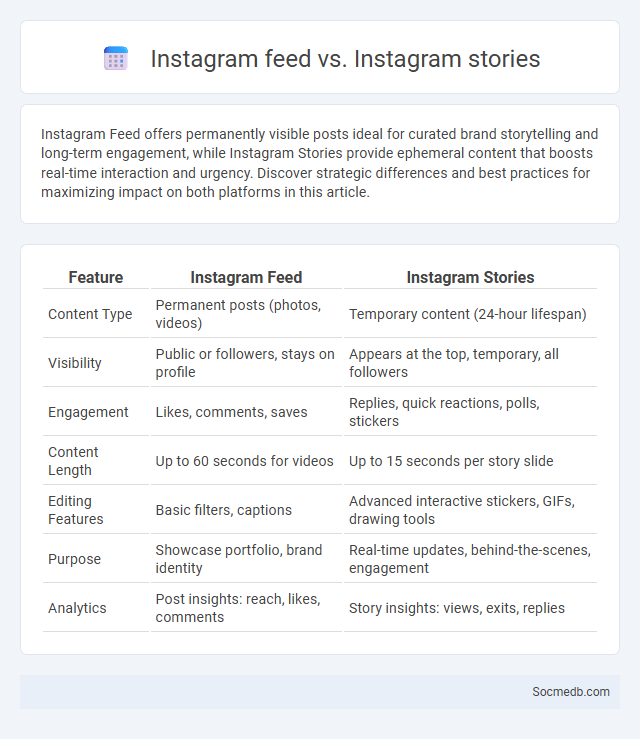
Photo illustration: Instagram Feed vs Instagram Stories
Instagram Feed offers permanently visible posts ideal for curated brand storytelling and long-term engagement, while Instagram Stories provide ephemeral content that boosts real-time interaction and urgency. Discover strategic differences and best practices for maximizing impact on both platforms in this article.
Table of Comparison
| Feature | Instagram Feed | Instagram Stories |
|---|---|---|
| Content Type | Permanent posts (photos, videos) | Temporary content (24-hour lifespan) |
| Visibility | Public or followers, stays on profile | Appears at the top, temporary, all followers |
| Engagement | Likes, comments, saves | Replies, quick reactions, polls, stickers |
| Content Length | Up to 60 seconds for videos | Up to 15 seconds per story slide |
| Editing Features | Basic filters, captions | Advanced interactive stickers, GIFs, drawing tools |
| Purpose | Showcase portfolio, brand identity | Real-time updates, behind-the-scenes, engagement |
| Analytics | Post insights: reach, likes, comments | Story insights: views, exits, replies |
Introduction to Instagram Feed and Stories
Instagram Feed showcases curated photos and videos on a user's profile, creating a permanent visual narrative optimized for engagement through likes, comments, and shares. Stories offer ephemeral content lasting 24 hours, designed for real-time updates, interactive polls, and behind-the-scenes glimpses, enhancing user connection and visibility. Combining both features maximizes brand presence by balancing longevity with immediacy in social media strategy.
What is Instagram Feed?
Instagram Feed is the curated collection of posts that appears on your profile and in the main scrolling timeline, showcasing photos, videos, and carousel posts shared by you and accounts you follow. It serves as the primary interface for engagement, allowing users to like, comment, and share content, which helps increase visibility and interaction. Your Instagram Feed reflects your personal or brand identity, making it essential for strategic content planning and audience growth.
What are Instagram Stories?
Instagram Stories are temporary photo and video posts that disappear after 24 hours, allowing users to share moments in a casual, ephemeral format. These stories appear at the top of the Instagram feed, providing a highly visible space for real-time updates, behind-the-scenes content, and interactive features like polls and stickers. Leveraging Instagram Stories boosts engagement by offering dynamic storytelling tools that enhance user connection and brand visibility.
Key Differences: Feed vs Stories
Social media feeds display a continuous stream of posts, allowing users to scroll through a mix of images, videos, and text that remain accessible over time, emphasizing permanence and discovery. Stories are ephemeral, typically lasting 24 hours, designed for spontaneous, real-time sharing with interactive features like polls and stickers that enhance engagement. While feeds prioritize curated content and algorithm-driven reach, stories foster immediate connections and highlight authentic, momentary experiences.
Audience Engagement: Feed vs Stories
Audience engagement on social media varies significantly between feed posts and stories, with feed content often generating higher long-term interaction due to its permanence and discoverability through algorithms and hashtags. Stories, by contrast, offer ephemeral, real-time engagement that encourages immediate responses via interactive features like polls, questions, and swipe-ups, making them ideal for driving quick audience interaction and fostering a sense of urgency. Brands leveraging both formats can maximize reach and engagement by combining feed posts for sustained visibility and stories for dynamic, direct communication.
Content Longevity and Visibility
Content longevity on social media directly impacts your visibility, as posts with extended relevance continue to attract engagement over time. Crafting evergreen content, using targeted keywords and hashtags, ensures your social media presence remains discoverable across search algorithms and user feeds. Consistent updates and strategic reposting enhance the lifespan of your content, maximizing audience reach and interaction.
Best Content Types for Feed
Visual content such as high-quality images and engaging videos dominate social media feeds, driving higher interaction rates and sharing. Carousel posts and infographics attract your audience's attention by delivering valuable information in a digestible, visually appealing format. User-generated content and behind-the-scenes footage build authenticity and foster stronger community connections, boosting overall engagement.
Best Content Types for Stories
Short videos, polls, and interactive quizzes rank among the best content types for social media stories, driving higher engagement and viewer retention. Visual storytelling using vibrant images and behind-the-scenes clips helps maintain audience interest and boosts brand visibility. Your use of timely, authentic content in stories can maximize reach and foster stronger connections with followers.
When to Use Feed vs Stories
Feed posts on social media are best for sharing evergreen content that benefits from long-term visibility and engagement, such as announcements, tutorials, or product showcases. Stories excel in delivering timely, ephemeral updates like behind-the-scenes moments, flash sales, or interactive polls that encourage immediate viewer interaction. Choosing between feed and stories depends on the content's lifespan and the desired level of audience engagement.
Choosing the Right Strategy for Your Brand
Selecting the right social media strategy requires understanding your target audience's preferences and behaviors on platforms like Instagram, Facebook, and TikTok. Analyzing engagement metrics such as likes, shares, and comments helps tailor content to maximize reach and brand loyalty. Incorporating a mix of organic posts and paid advertisements ensures effective visibility and conversion rates.
 socmedb.com
socmedb.com